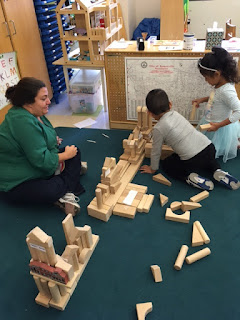Many of our families in Somerville work multiple jobs, live in less than ideal housing situations that impact food, sleep, social emotional development, and of course a child's ability to learn. We must work tirelessly with policy makers and city leaders to overcome the factors that contribute to poverty and toxic stress impacting many families today. And Somerville is doing just that through our family engagement and inter-agency work, and the By All Means initiative out of the Education Redesign Lab at the Harvard Graduate School of Education (more on that in a later blog). Playgroups, home visits, wrap around services, family liaisons, and health initiatives support families and children.
But we can't continue to focus only on societal challenges.
Then, in one of the sessions at NAEYC this slide popped up:
Causes of the Achievement Gap
- Injustice
- Inequality
- In-opportunity
Depends on where you sit - and this is where another important narrative emerged.
Maurice Sykes, Executive Director of the Early Childhood Leadership Institute at the University of the District of Columbia’s National Center for Urban Education, reiterated across two forums I attended that those of us who work with young children (and the teachers who engage them) have to maintain a strong focus on the best possible experiences we can offer for the time that children are in our care, or for the time we are providing professional development or coaching.
And we have to think carefully about our Circles of Concern, Circles of Influence, Circles of Control. Too much focus on Concern and we can become reactive and overwhelmed. Too much only on Control and we lose sight of our role in the big picture. The key here is the relationship between our Circle of Influence and our Circle of Control. And teachers actually have more influence and control than they think they do.
As teachers, your practice is at the heart of what you can control. Whether you have our children for 5, 6, 7, or even 10 hours a day you must continue an unrelenting focus on the experiences children have. You/We must:
- design beautiful and interesting environments that reduce trauma.
- offer practices that keep children's interests, play, Big Ideas/themes, and their desire to communicate (in speaking, drawing, and writing) at the heart of what is offered.
- make sure that we understand children's developmental trajectories in academic, physical, and social emotional learning.
THINK: What do I need to do or to learn in order to for my circles to have the greatest impact on the achievement gap?
Here is a little inspiration from our classrooms as you think about your Circles of Influence and Control. Children are capable, curious, and want to learn.
Early childhood education IS rocket science and we have to start treating it that way.
 |
| Receiving tiny notebooks to record drawings, ideas, representations, words. |
 |
| Labeling block structures that represent the building the classroom is in. |
 |
| Making maps with curated materials |
 |
| Building vocabulary connected to an investigation base on the Big Idea: Where does our food come from? |


No comments:
Post a Comment